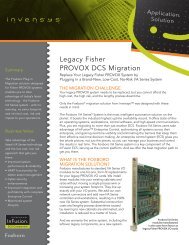New 49 CFR Requirements Mean New Strategies for Pipeline ...
New 49 CFR Requirements Mean New Strategies for Pipeline ...
New 49 CFR Requirements Mean New Strategies for Pipeline ...
You also want an ePaper? Increase the reach of your titles
YUMPU automatically turns print PDFs into web optimized ePapers that Google loves.
Sponsored by3. Controller/Operator TrainingAny time an emergency occurs, a plantcontroller or operator must instinctively knowwhat to do. He must be trained to respondreflexively. A comprehensive training programnot only is required by law, but also helps ensurecontrollers and operators respond properly toall situations which occur in the plant and havehad the opportunity to practice how to respondin advance. Training promotes safety, reducesdowntime and makes good sense.According to <strong>49</strong> <strong>CFR</strong> 195.446/192.631 (h):training, ”facilities must establish a trainingsystem <strong>for</strong> controllers which teaches them tooperate their systems in all types of conditionsand trains their operators to communicate toother areas during emergencies.” Training simulatorsplay a significant role in helping facilitiesmeet these requirements. However, today thetraining paradigm has shifted beyond HMI navigation,alarm handling, and system stabilizationand consequently requires significant considerationby the training organization and the compliancegroup. The training environment must coverthe entire set of operations a controller encounterseach day. The controller must be trained tohandle all elements of communications to plantpersonnel and more.The law states a facility must establish acontroller training program and review thecontent of that program to identify possibleimprovements at least once each calendaryear and at intervals not exceeding 15 months.Training must include the use of a computerizedsimulator or non-computerized (tabletop) methodwhich trains controllers to recognize abnormaloperating conditions. Further, it requires what-ifscenario training.The law also recognizes field personnel as animportant part of any operator safety and maintenanceprogram. Because these personnel areseparated from control centers, typically operatingin remote locations, remote telemetry andstandardized instructions are required to achievethe security required by the <strong>49</strong> <strong>CFR</strong> amendments.An embedded training system should give operatorsthe ability to review setups and other proceduresused regularly but infrequently in advanceof their application.Tools: Advanced simulation-based applicationssuch as those offered by Invensys’ SimSci-Esscorand Energy Solutions International (ESI) providehigh-level automated computerized training,which embraces all requirements noted in thenew regulations. Their pipeline managementtraining environment resides within the overallsystem plat<strong>for</strong>m to incorporate this complianceelement into a cohesive and integrated system.Numerous applications can be simulated, fromsimple tie-back control to more complex activitiessuch as understanding workflow, roles andresponsibilities, accessing shift logs, and muchmore. Trainees work directly on the SCADAsystem using a dedicated training console. Theinstructor is able to set up pre-defined trainingscenarios or introduce changes and upsets, andthen observe and assess operator reactions.Complex batch, capacity optimization, leak detection,and tank management applications, amongothers, may also be simulated.The bottom line: This tool provides a trainingenvironment, which includes all SCADA specificfeatures, realistic alarm handling, and the overallcommunication tools and procedures required insection (b) and (c) of the law, in particular.Benefits. Integrated training simulators offer thefacility a variety of tools <strong>for</strong> meeting the educationalneeds of controllers, operators, and otherpersonnel at all levels. Specifically:Compliance managers can be assuredoperators and instructors are educated in anenvironment that allows the creation of specificmultiple, dynamic what-if scenarios to whichoperators can react. They can ensure measurableresults generated by the system’s built-ingrading mechanism, which allows per<strong>for</strong>manceto be qualitatively and quantitatively defined.And they also benefit from the knowledge controlroom personnel have seen and have been trainedto handle the entire set of actions they mayencounter prior to the events taking place.7Control room SCADA managers can be surethe training system meets regulation requirementsto completely emulate the real workingSCADA system. This occurs in terms of operatorinteraction and the timing of processes and logicthrough the use of a virtual PLC, or controller,and the presence of two-way communicationbetween each application. Use of a computerizedtraining system allows managers to presentscenarios to the controller [as noted in section(h) (4) of the law] that would be difficult toconstruct without anautomated system orwith a generic controlenvironment.Plant engineerscan be assuredpersonnel and technicianshave been trainedand tested on their fullset of responsibilities andhave working knowledgeof the pipeline system,especially during thedevelopment of abnormaloperating conditions.<strong>New</strong> Laws <strong>Mean</strong> <strong>New</strong> <strong>Strategies</strong> <strong>for</strong><strong>Pipeline</strong> Control Room ManagementExecutive Guide to<strong>49</strong> <strong>CFR</strong> RegulationsSponsor Profile




